I have been working in Seattle recently and I always drop by the Bellevue Botanic Garden, knowing great photos are to be found. Walking around the groundcovers garden I came upon this scene.
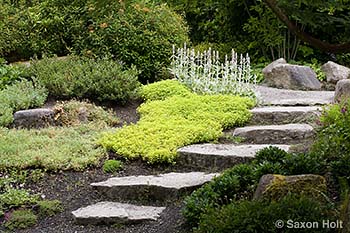
path in Bellevue groundcover garden
My photographer’s radar switched to acute knowing this was a scene to be worked, to savor, to discover a special photograph. Let’s analyze.
Right away I note the upright flowering spikes of Stachys byzantina are at the edge of the path, isolated from any distraction. There is a slight incline so I can easily get my camera and tripod at plant level. With a medium telephoto lens I can fill up the frame from a low angle some few feet away.
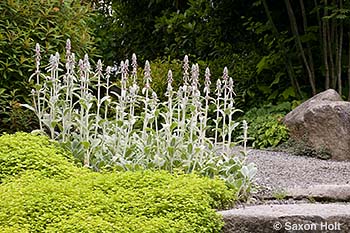
flowering Lamb's Ears
When I composed this picture I simply framed up the most important elements of the original scene: the path with the nice boulder, the flowering Stachys, and the wonderful charteuse foliage of golden oregano. But I know there is more; I am working the scene. Note the nice strong design element of the multi-trunked Japanese full moon maple tree. I have used it as a compositional element in the upper right. Now I will try to use it more dramatically.
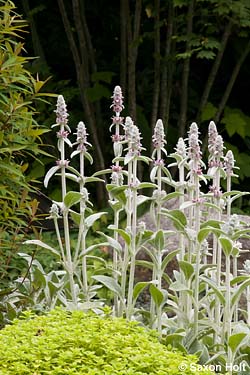
Stachys in front of maple
I come around the scene a bit to put the flower spikes of the Lamb’s Ears right in front of the maple trunks, meanwhile obscuring the boulder. As a vertical photo both elements now work together, and there is the added bonus of the angled tree trunks, adding a visual ray effect, pulling the eye into the photograph. Using a telephoto lens, I have sandwiched the design elements together but have left the background out of focus just enough so that the center of attention is the gray foliage Stachys.
Ah, but let’s not forget the other plant that grabbed my eye when I turned the corner of the groundcover garden.
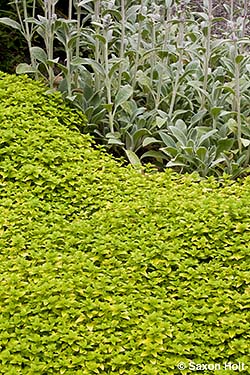
Golden oregano groundcover
The bright foliage of Golden Oregano (Origanum vulgare ‘Aureum’ ) makes a striking photo especially when paired up with the gray foliage of the Stachys. I have paired the two plants together in the compostion, not simply to show off the contrasting foliage colors but to give the viewer a sense of scale in how to use the plants. Also, I draw your attention to a classic composition technique, the “rule of thirds”. The photo is composed with a balance of 1/3 and 2/3 which for many eyes is a naturally pleasing proportion.
Now I come around to the top of the path and look back down, framing the gray lamb’s ears in front of the mass of chartreuse.
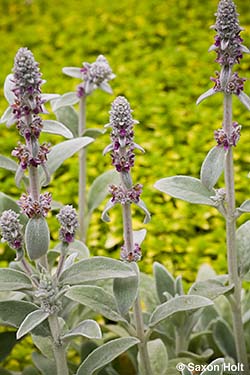
Flowering Stachys - Lamb's Ears
The camera alway’s lies – one might think there was a sea of golden oregano groundcover. Careful framing makes this possible. That, and spending enough time working the scene to see the possibilities. Look back at the first photo to remember how we got to this point.
When you stumble across a photo opportunity, spend a little time with it, distilling the essence and frame out the distractions. Let the camera tell the story that you want it to tell.
